Okay let’s get right into it here – this article is to cover basic pros and cons of a solar mobile charger vs a power bank.
Solar chargers provide power to your phone or device by converting solar power into electricity. Power banks have internal batteries that store electrical energy for you to use to power your phone or device.
If you’re ready to buy and looking for a recommendation I hope this will narrow your focus. Without knowing your specific situation, it is hard to know exactly what will work best for you. Every outdoor adventure is different. There are many variables that go into what type of charging device would best suit your specific needs. In this article I want to highlight some pros and cons that will hopefully help you understand what you need. After listing the pros and cons of each, I will then go over these three specific scenarios to discuss how they might work:
- Hunting/Hiking Trip with base camp
- Thru or Section Hiking trip with no base camp
- One-day outdoor adventure. Example: Lake/Concert/Youth Sports Tournament/Day Hike/Fishing
Without diving deep into the specific mechanics, here is a broad definition of each of these devices.
What is a Solar Mobile/Device Charger?
A solar charger uses solar panels to convert solar energy from the sun into electricity which can then be used to power your phone or device.
What is a Power Bank?
A power bank is a portable charger with an internal battery that itself can be charged. The battery can store electrical energy for you to use to power your phone or device later. Much like a financial bank holds your deposited money for later use, a power bank holds deposited electrical energy for you to use later when you are away from power sources.
Pricing Comparison of a Solar Charger vs. Power Bank
Portable solar chargers with foldable solar panels can range in price from approximately $30 to $250 depending on the brand, amount of power in watts, and overall charging capabilities. Some of the higher end solar chargers can offer up to 200 watts of power and the capability of charging car batteries, among other features. Although “portable”, some of the more expensive options can be larger and probably not something you want to carry around with you if you are simply looking to charge small devices.
The lower end of the price range will offer around 7-14 watts of power. Depending on brand and exact number of watts, some of these solar chargers may take 6+ hours of direct sunlight to fully charge your phone.
If you are simply looking to charge small devices like your cell phone, you will not need an expensive power bank (but those more expensive/more powerful options may work for you if you have greater needs than to charge simple devices).
Portable power banks that you might be looking to stuff in a pocket can range in price from $20-$125 depending on brand and energy storage capacity. We will get into the details of storage capacity later when we discuss power bank scenarios.
Sizing Comparison of a Solar Charger vs. Power Bank
How the size of these devices impact you will be determined by your specific needs. Although the power bank is quite smaller, if you need multiple power banks, that changes things obviously. I have included a lot of pictures here for reference. They can give you an understanding of the size of the solar charger and power banks that I own. As I state above, I own a RAVPower solar charger and Anker power banks. I opened up one of my power banks I haven’t used yet so that you can see the packaging and what comes with it.
Solar Charger Size
Obviously, sizes differ across brands. Wanted to give some pictures of size so that you can have an idea of what to expect from a solar charger.
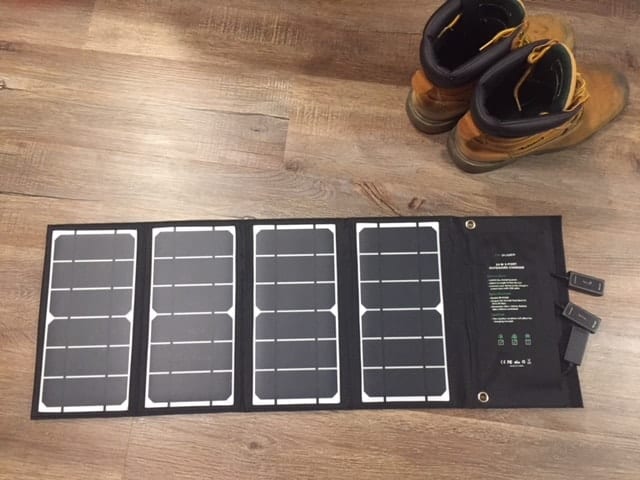
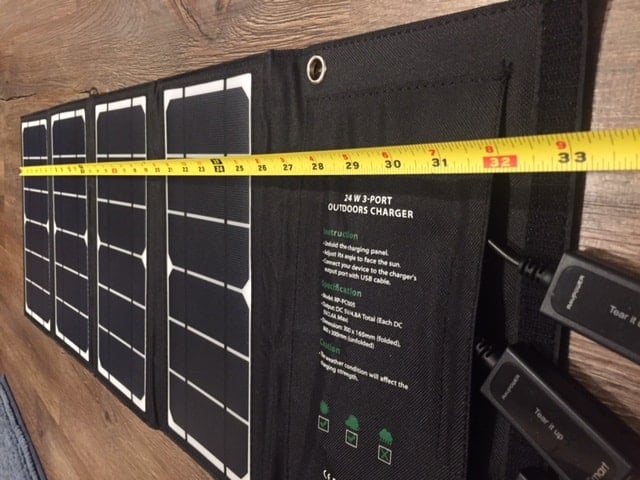
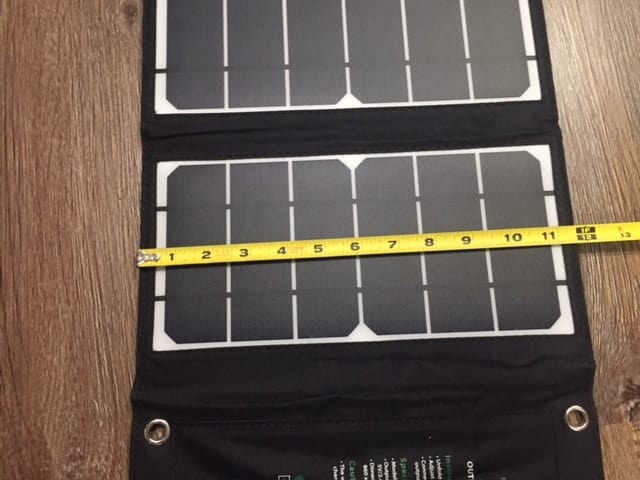
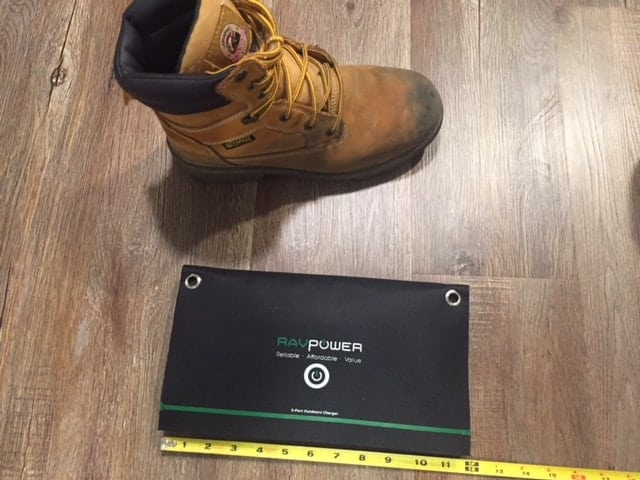
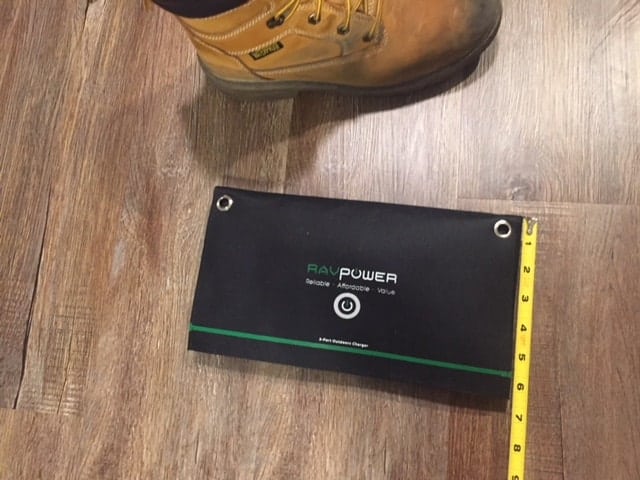
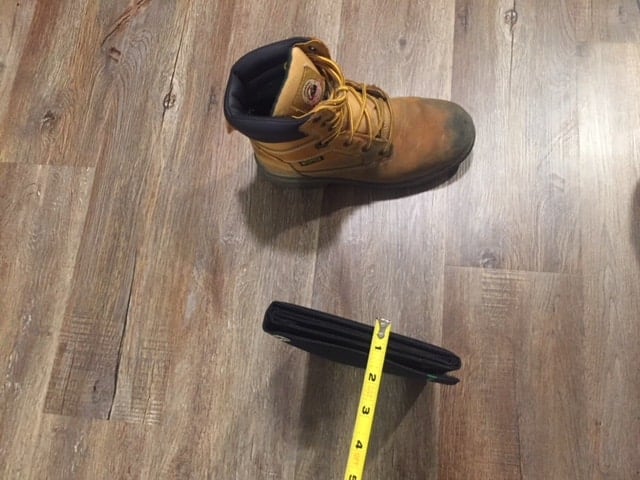
Power Bank Size
As I stated above, sizes differ across brands and storage capacity. This example is just to give you a point of reference regarding the size of a power bank.
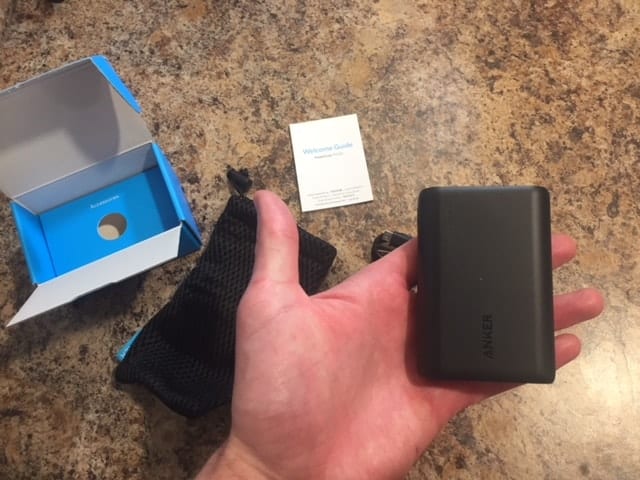
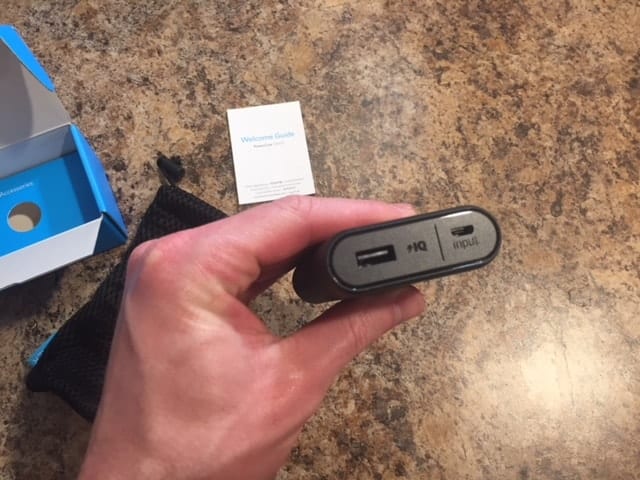
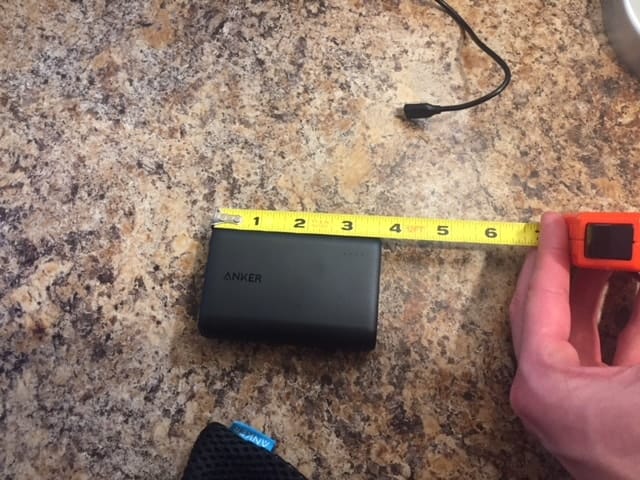
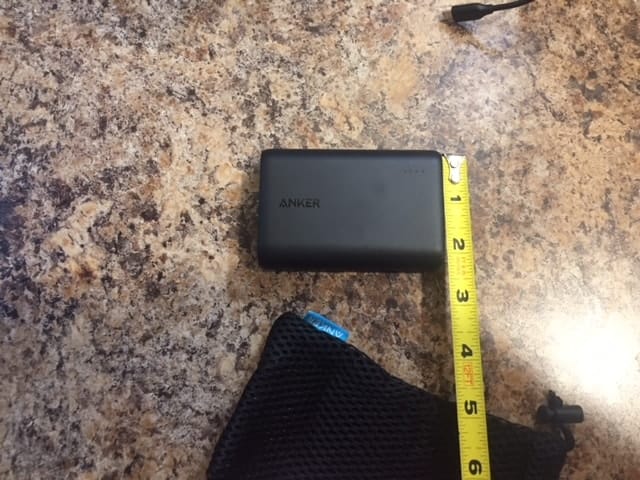
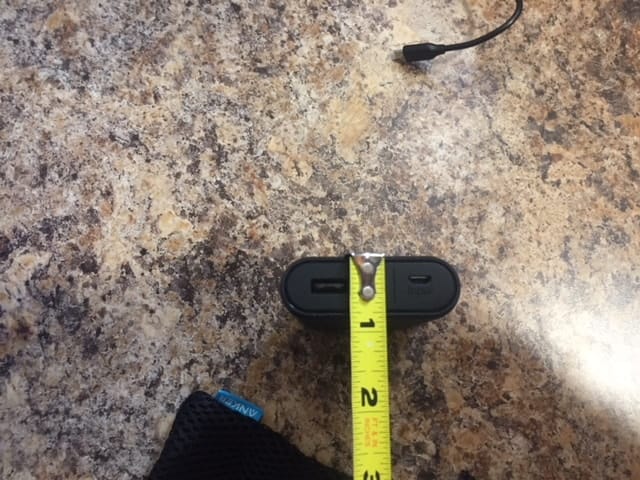
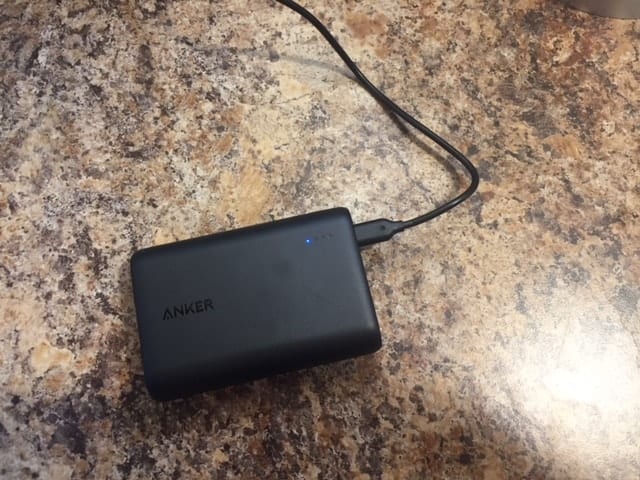
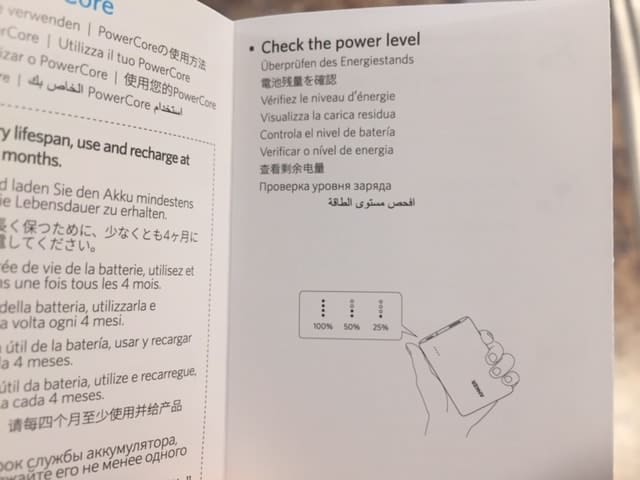
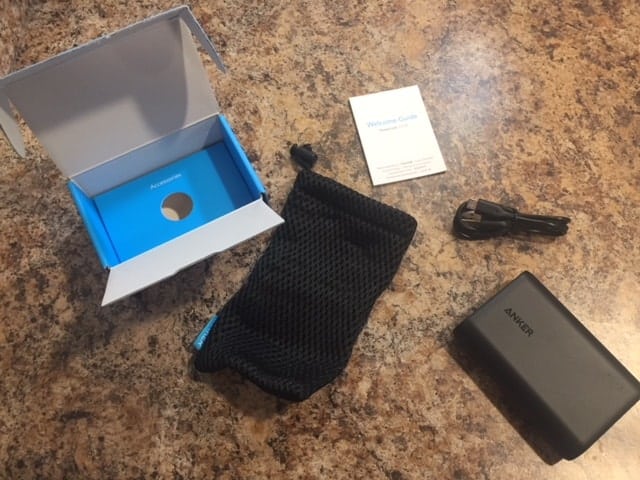
Weight of a Solar Charger vs. Power Bank
My RAVPower 24 watt solar charger weighs 1.65 pounds. If you prefer something lighter, some of the lower-watt chargers weigh less than a pound. My Anker PowerCore 10000 power bank weighs 6.35 ounces. Some larger capacity power banks can weigh up near 13-14 ounces.
Clearly, power banks individually are lighter that solar chargers. But the question remains, how many power banks will you need? Hopefully the information listed below can help you figure that out.
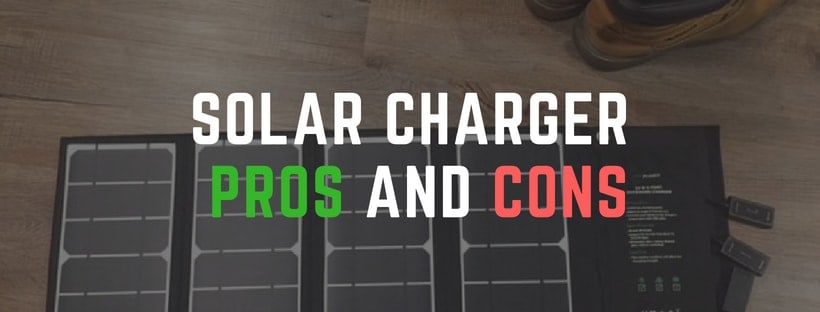
Solar Mobile Device Charger Advantages and Disadvantages
Pros
Potential endless supply of power
If the sun is up, and you have access to it, you can get convertible energy.
Sunlight is available everywhere
Even if you are in a part of the world where electricity is not available, you can rely on your solar charger to provide power to devices when needed. They can also charge your power banks.
Does not have to be pre-charged
Not much prep work needed. Just pull out the panels and connect your phone or device and let it charge. Power banks can take a long time to charge themselves, before they even charge your device. This means prep work. Will you have time for that? Something to consider. A solar charger can take significant time to charge a device. If your phone battery is near 0%, you will need (depending on brand and type) possibly 3+ hours to fully charge your phone.
Environmentally friendly
Solar power converted to electricity is clean energy that doesn’t leave a carbon footprint. This factor is important to many people.
Cons
Weather dependent
Weather will play a factor in your ability to get solar energy. This leaves open scenarios where you start your outdoor adventure, and when the weather doesn’t cooperate, you’re left without a power source.
For cloudy days, you may still be able to get your solar charger to produce 25% of its rated capacity. But exactly how much power you get is dependent on how severe the cloud cover is, among other factors. We will discuss this more later when we talk about a recommended solution.
Needs direct sunlight
If you are hiking along a trail during the day and hoping to charge a device with solar panels clipped to your backpack, it can be difficult to pull off because those solar panels need direct sunlight to work properly. As you walk, you constantly change directions and angles. Your body will be shielded by tree and hills. If you do not give it direct sunlight, it might not charge, or it might charge at a much slower rate.
Needs space
If you are hoping to take your solar charger to the lake with friends, don’t forget about space. You will need to unfold the solar panels and spread them out. So, if you are sitting at a table amongst friends, you might not have space to just spread out the panels.
You would need to take the solar panels off into an open area with direct sunlight and let your device charge. If this is away from where the group is, you will have to be without your device for a while so that it can charge. This is an example of where a power bank would potentially solve that problem.
Time
Can take 3+ hours to charge certain devices, and even longer if sun is not direct.
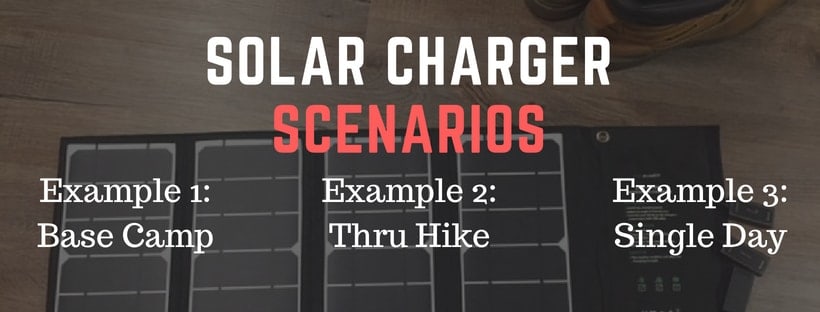
Solar charger scenarios
Will using ONLY a solar charger work for week long hunting trip or a hiking trip with a base camp?
Will you have access to direct sunlight and will the weather cooperate? If yes, next thing to ponder is how often will you be at your base camp? If you plan to be at base camp only at night, then you may have to leave your charger and device behind to charge under direct sunlight. This of course could be a hassle if you wish to use your device during the hike or hunt, which you probably will.
The problem is if you take your device with you, by the time you return to base camp, it may be too dark to charge your device. (The solution may be to combine a solar charger with a power bank, which we will discuss later.)
If you wish to use your device during the day and charge it during the day, finding direct sunlight during your hike or hunt may be hard. The changing of directions combined with tree and hill cover may make finding consistent direct sunlight difficult.
The next option is to stop during the day and find direct sunlight and charge your devices. But is that something you and your hiking or hunting party will want to do? The answer to that question will determine your plan of action. To fully charge a phone may take a couple hours if you expose it to direct sunlight. But if you’re simply looking for something that can give you an emergency boost of power if needed, then a solar charger could do that in 10-15 minutes.
Also, what if you have multiple devices amongst your group: 4 phones, GoPro camera, lantern and a drone? It could take an entire afternoon to charge all these devices depending on what solar charger you have. Even though many solar chargers come with multiple USB outlets, you may need to have two separate solar chargers to handle the charging if you have a handful of devices.
CONCLUSION: Using ONLY a solar charger for a base camp hunting or hiking trip
GRADE: “B-”
Weather dependent, but if weather looks good, you will have a few charging options to pick from. These options may be a bit of a hassle but it’s likely that your hunting or hiking party can find one that works best for you.
Will using ONLY a Solar Charger work for a Section Hike or a Thru Hike?
Under this scenario, we are assuming that you have no base camp that you return to every day. You are thru hiking or section hiking and setting up a new camp every night. This removes your ability to charge at camp during the day and then return to camp later in the night to a fully charged device.
Solar charging while on your hike (by clipping to your pack) may prove difficult because you change directions and angles and dip out of direct sunlight.
But although solar panels might not be ideal, they are in many ways necessary for a thru hike. At some point, you need an energy source. If you are not stopping at hostels along the way, you may need to use solar energy. You don’t want to have to stuff your backpack with handfuls of power banks that will eat up valuable space and weigh down your pack.
Most thru hikers however do eventually stop at hostels or restaurants along their lengthy journey to shower, eat, and power devices. If you plan to stop on a daily basis, you may not need a solar charger.
But something I think is important to remember about solar chargers, is they allow you to be flexible. If something unforeseen happens while on the trail – change of schedule, emergency injury etc – a solar charger can provide you access to power for as many days as you need as long as you are exposed to direct sunlight.
If you choose to use a solar-powered charger you will need to commit to take time under direct sunlight to stop your hike and charge devices. Although this is very doable, it may cause a deviation from your routine, which may not be desired.
CONCLUSION: Using ONLY a solar charger for a section hike or a thru hike:
If your trail has direct sun access – GRADE: B
If your trail does not have consistent direct sun access – GRADE: D
This is a tough grade to give because no two trails are the same, so I split it up a bit. If you are on a hike in Arizona, you will have access to much more direct sunlight that if you were hiking the Appalachian Trail. On a trail with poor access to direct sunlight, a solar panel will not be reliable and therefore it would be difficult to recommend.
But for long hikes, you will want some sort of power source (especially if you don’t plan on stopping at hostels along the way to charge devices), and a solar panel power source can provide you that if given adequate access to direct sunlight. (Again, the best solution may be to combine a solar charger with a couple power banks. We will discuss below.)
Will using ONLY a solar charger work for a one-day outdoor event?
Example includes day hike, lake trip, youth sports tournament, concert, and fishing etc.
Will you be outside with direct sunlight? How is the weather? If those things cooperate, then solar charging your devices can be a good option under these scenarios.
How many devices will you have? Is your family large and diverse? You may need to charge 5+ phones, and a couple tablets, a gaming device, a digital camera, and a Bluetooth speaker. Does this sound like your family? If so, consider the amount of USB outlets the solar charger has. You may need multiple solar chargers to cover a large family like this.
CONCLUSION: Using ONLY a solar charger for a one-day outdoor event.
GRADE: B-
It’s still weather dependent, which knocks its grade. But if you have good weather, you should be able to keep your devices powered and ready to use. Because this is a shorter outing, this may be an example of where a power bank would work better and therefore I knocked the grade down to a B-.
The size of your family/party, and the number of devices will determine that. Again, you probably don’t want to have to bring handfuls of power banks. If you have a lot of devices, you will want to strongly consider a solar charger in some capacity. And if you have a lake cabin that your family often retreats to, the solar charger is something you can leave there and not have to worry about packing every time.
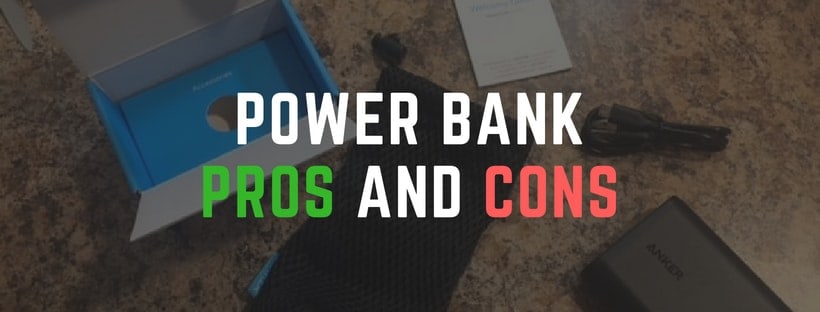
Power Bank Advantages and Disadvantages
Pros
They do not depend on weather
Power Banks do not depend on the weather like a solar panel does.
Indoor use
Ability to use them indoors when a storm knocks out the power to your house.
Very portable
Easy to move, especially if you only need one to charge a phone. You can easily carry a small power bank in your pocket.
Cons
Mis-leading charge rates
The advertised mAH charge capacity is wrong. As a rule of thumb, you can expect the actual charge capacity to be approximately 2/3 of what is advertised on the box. We will get into the detail of this below.
Charging
They too will need to be charged. Although they can supply energy for your devices, they cannot produce energy. Eventually they will need to be re-deposited with electricity.
Bulk Weight
Using just power banks on a week-long section hike with multiple devices like phone, camera, lantern, and tablet will cause an issue. You will need to carry likely a handful of power banks to keep these devices charged throughout your trip. Bulk power banks can add weight and take up precious space in your pack.
Size
Truthfully, this could be a pro or a con depending on how you need it. Power banks takes up much less room than solar panels. However, the size of a power bank can still be clumsy. Larger power banks can be too bulky for a pocket. If you are just wanting to find a power bank to shove in your pocket, there may be some slimmer types that work well for you.
Price
To get the best power banks on the market you may have to be willing to spend $50-$100. Now remember, if you feel like you will need multiple power banks for a thru hike, this can be a costly issue.
Power Bank Details and Pointers
Before we dive into some specific scenarios, let’s cover some basic information regarding power banks just so that you are informed. If you are familiar with power banks, you can skip to the scenarios below.
Power banks charge with electricity. Charging your power bank can be done simply by connecting to a wall outlet or some other type of device like a solar charger or generator. One thing you will want to consider now as you begin your buying process is to remember that these power banks themselves take time to charge. There are several variables for power banks:
- Size and weight: Are you backpacking? If so, this could matter.
- Charge Energy Capacity: The charge energy storage capacity is measured in milliamp hours (mAH). The more mAH, the longer the battery will last. You need to decide, how much capacity will I need in a power bank to charge all my devices over the course of my trip?
- Charge Time: Charging power banks does take time. If your cell phone has a mAH battery capacity of 2800, and your power bank has a capacity of 15000, well that is over 5x the amount of capacity. So, if it takes your phone an hour to charge 2500 mAH, it could take upwards of 5-6 hours to charge the power bank itself. Will that be a nuisance for you? Something to consider.

Power Bank Frequently Asked Questions
Size and specifics of a power bank: What size of power bank will I need to power my phone?
As we discussed above, charge energy capacity (a power bank’s storage capability) for power banks is measured in milliamp hours (mAH). You will also want to know the mAH for the battery of your device(s). This is going to give you an idea of what size of power bank you will need.
In theory, a 3000 mAH power bank fully charged should have the exact amount of energy needed to charge a 3000 mAH device. The problem is, it doesn’t quite work that way. Some power will be lost through conversions between your power bank and the USB cable and between the USB cable and your phone/device, along with other issues. As a rule of thumb, 20-30% should be deducted off the advertised out-of-box mAH to get a more realistic number of actual usable mAH.
Also, as with anything in life, some power banks don’t quite live up to their billing. You get what you pay for usually. Cheaper power banks may advertise a 5000 mAH capacity, but when you start powering your device with a battery capacity of 2800 mAH, you find out the 5000 mAH power bank barely has enough juice to fully charge the 2800 mAH device battery once. So, just keep that in mind as a word of caution.
Example
In this example, I am going to operate under the scenario that you are going on a one-day hike with a cell phone that has a battery capacity of 2716 mAH and a digital camera that has a battery capacity of 1500 mAH. You plan on needing to re-charge both devices once while on the trail. What size of power bank will you need?
Let’s add the capacity of the two batteries together to get a total mAH of 4216. We will treat this as an absolute minimum of what you will need. But remember, energy can be lost while charging. The heat you feel near your device while charge is energy that is being lost. You can expect to lose some small amounts of energy between your power bank and your USB cable and your USB cable and your device.
And as we stated above, we want to plan for a 30% loss on the out-of-box advertised storage capacity. So, for this example, we would need an out-of-box mAH of 6023 to feel comfortable charging 4216 mAH from our devices (6023 – 30% = ~4216).
How many times can I charge my phone with a power bank?
To answer this, you will need to look up the mAH storage capacity of your phone battery and then compare it to the storage capacity of a power bank you own or are looking to buy. A quick google search should be able to tell you the capacity of your phone battery.
Remember, again, you want to adjust the out-of-box storage capacity of the power bank down by approximately 30% to account for conversion losses etc. So, to figure how many times you can charge your phone, you will take:
Out-of-box mAH of your power bank and subtract 30%, then divide that result by the mAH of your phone battery. This will give you the number of times you should be able to power your phone with the power bank. (Power Bank mAH – 30%/phone mAH)
For example, if you own a power bank that advertises out-of-box capacity of 10000 mAH, and your phone battery capacity is 2500 mAH you would have:
10000 – 30% = 7000. Then take 7000/2500 which equals 2.8.
That power bank approximately would give you 2.8 full charges to your phone. But remember, the 30% reduction is just a general estimation and every power bank has a different level of efficiency.
Can I charge multiple devices at once with a power bank?
This answer is dependent on the type of power bank you have, but yes, many power banks allow you to charge multiple devices at once.
Are there power banks available that support Qualcomm Quick Charge?
Yes, there are power banks that support Qualcomm Quick Charge capabilities. Some power banks have both quick charge output and input. Here is a PC Mag article on quick charging.
Can I charge my device while charging my power bank?
This also is dependent on the type of power bank you use. But yes, some power banks do have pass-through charging capabilities.
Why will I lose mAH while charging from a power bank?
One of the key things I wanted when creating this post was to avoid a deep dive into the specifics of the mechanics of these devices and how they work. You are likely here because you just want to know what you need. And I want to answer that to the best of my ability without knowing your specific situation.
Quickly, let’s just cover why out-of-box advertised mAH may be misleading. I want to do this because this is something that could really trip you up when you go to buy. I don’t want to see you purchase a power bank and then get miles into the woods and find out it won’t fully charge your devices.
Many power banks operate on 3.7 volts. So, if it advertises 15000 mAH charging capacity, it’s only relevant at the 3.7v level.
Now, for a USB cable, that runs at 5 volts, when the conversion from 3.7v to 5v occurs during the charge, I’m going to take our original out-of-box numbers for the power bank (3.7v 15000mAH) and multiply them, then divide them by the 5v of the USB cable. This gives me 55,500/5= 11,100 mAH. That 15000 mAH has been converted down to 11,100 mAH. That’s a 26% loss from the out-of-box mAH.
Are you still with me at this point or am I writing to a ghost town? Hello? Anyone? Hello?
Okay. That’s enough math for now. Always remember to account for the loss of energy through conversion.
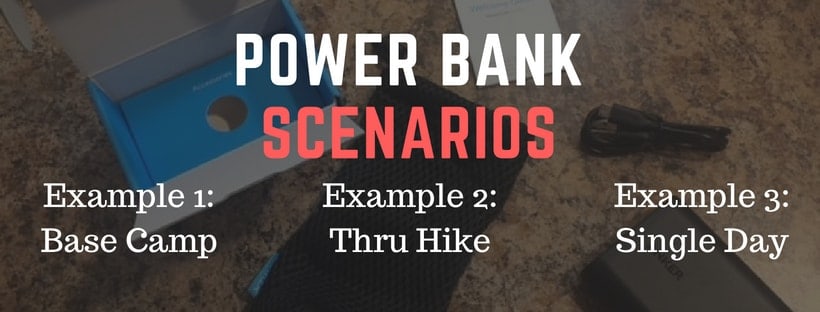
Power Bank Scenarios
Will using ONLY a power bank(s) work for week-long hunting or hiking trip with a base camp?
Do you have alternate power sources available that can re-charge your power bank throughout the week. Does your base camp have electricity or a generator that can re-charge your power bank? If the answer is yes, then a power bank should be more than adequate to power your devices while you are away from base camp. Just recharge your power bank every night.
Let’s dive a bit deeper here and discuss the scenario where you don’t have access to a power source. Your cabin or camp does not have a generator or electricity. Will a power bank(s) by itself be able to get you through a week?
Without knowing your specific situation, the answer is yes it probably could, but there would be much more realistic options.
Example
Let’s assume you have multiple devices: phone, camera, lantern, and USB-powered fan (there are a multitude of other devices you could have as well such as laptop, flashlight, tablet, portable shower, drone etc). We will estimate:
- Phone 2800 mAH recharge 5 times (2800×5)
- Digital Camera 2000 mAH recharge 2 times (2000×2)
- Lantern 800 mAH recharge 2 times (800×2)
- Fan 4400 mAH recharge 2 times (4400×2)
So, for our example, we estimate that we will need to be able to charge a total of 28,400 mAH to power all our devices for the week.
Let’s also remember that due to conversion loss and other factors, 25-30% of the advertised out-of-box charging capacity of your power bank will be lost during a charge. So, we need our estimated total to be reachable even after we deduct 30% off the out-of-box advertised mAH of our power bank.
In this case, 40,571 mAH, if we then took off 30%, would give us a total usable mAH of 28,400. (Too much math again my apologies)
But now we know that if we wanted to power these devices throughout the entire week with power banks, we would need out-of-box mAH of 40,571 or greater. This is a large amount of mAH and likely means you would need to purchase 2-4 power banks which could run your cost well over $100+. You will need to take the prep time to charge these power banks. Also, taking only power banks decreases your flexibility. What if someone brings an extra couple devices or if you use your devices more than you planned? What if you end up staying a few extra days? If you have no generator or electricity, and are relying only on these power banks, your flexibility will be greatly decreased.
CONCLUSION: Using ONLY power banks for week-long hunting or hiking trips with a base camp:
With alternate power supply like generator or electricity or solar charger – GRADE: A+
Without alternate power supply – GRADE: D
A power bank is a handy little power source that you can take with you out on the trail during the day in case you need to recharge a device. In my opinion, for week-long trips, they work best in tandem with another power source.
In the example we listed above, where we needed 40,571 mAH or greater, instead of trying to tackle all of that with just power banks, I would use an alternate power source (like a generator or solar charger). Maybe you buy two small 10,000 mAH power banks for under $30ish each. Each day you take one with you on the hike or the hunt. The other one you leave behind at the base camp charging on a solar charger.
While away, you can also use the solar charger to charge your camping fan and lantern etc.
The cost of a solar charger combined with two power banks can still easily cost near $100, or even exceed it, but with the solar charger comes the flexibility that power banks alone cannot offer. If your plans change, a solar charger will still allow you to have power even if it wasn’t planned for.
Will using ONLY a power bank(s) work for a section hike or a thru hike?
We are discussing whether using ONLY a power bank would work for a section hike or thru hike.
A power bank would obviously only work for week-month(s) long hiking trip if you also plan to stop consistently at hostels etc. where you can recharge your devices and power bank(s).
If you plan to stop on a nightly basis, a power bank would provide you with plenty of power while on the trail. If you are good at conserving power on your phone, you may not even need a power bank if you plan to stop at a hostel or hotel every night. (Although I personally would never try that.)
We also have discussed the decrease in flexibility. In my opinion it is always important to remain flexible, just in case something unforeseen happens. Alternate power sources give you some flexibility while out on the trail.
CONCLUSION: Using ONLY power banks for a section hike or a thru hike:
With stopping at hostels to re-charge – GRADE: B
If stopping at hostels is going to be an option, then power banks alone can be a reasonable solution. In my opinion, it is still nice to have a solar charger with you in case of emergency and if you are stranded on a trail for days. To me, flexibility is the key, and solar power provides that. But I will assign this a B grade. It is realistic to use only power banks if you will also be stopping to re-charge via electrical outlets throughout your trip.
What about taking no power banks if you plan to stop nightly at hostels? Can this be pulled off? Possibly. Would I want to try it? Likely no. There are too many unpredictable things that could occur where my limited power supply would put me in a bind.
Finding power sources during a thru hike can be difficult, especially on certain trails. Combining a solar charger with a power bank would be a possible solution that give you flexibility and peace of mind. But without knowing your specific trail, it’s hard to make a recommendation. Will your trail have access to sunlight? Will you be willing to stop during the day and allow direct sunlight to recharge your devices? If the answer to these questions is yes, the combination of a solar charger with USB ports and a power bank could be a perfect solution for your hike.
Will using ONLY a power bank(s) work for a one-day outdoor event?
Example includes lake trip, youth sports tournament, sports tailgating, concert, and fishing etc.
Power banks are ideal for these types of outdoor events. Pocket-sized power banks are easy to take with you and give you that extra boost if your device runs out.
Now there are scenarios where possibly you have so many devices that you need more than a power bank. If your family has a lake cabin and you have handfuls of devices, then perhaps at that point you’d want to consider combining power banks with a solar charger or small battery-powered generator.
But if you are simply headed out to watch your son or daughter play in an all-day youth sports tournament, a power bank is a perfect solution for powering your phone or device. If you are bringing a laptop, you will want to make sure your power bank is compatible with laptops.
CONCLUSION: Using ONLY a power bank(s) for a one-day outdoor event:
GRADE: A+
This is a perfect solution unless you have an extreme number of devices.
Combining a Solar Charger with Power Banks
I have referenced this combination several times throughout this post. Depending on your specific situation, this may be a solution that gives you the most flexibility. Staying flexible while on outdoor adventures is important. What will happen next is always unpredictable, and you want to have as many resources as possible. I own both and think they work best in tandem. Not all outdoor activities require both, but I always have that option if needed.
What about solar power banks?
If you’ve browsed power banks, I’m sure you’ve seen power banks that have a built-in solar panel that advertise with the ability to re-charge the internal battery with solar energy. I’m always a bit skeptical of these devices.
The amount of solar energy absorbed by one small solar panel would take an extended amount of time to recharge a large capacity internal battery. For example, let’s say you have a 25000 mAH power bank with a built-in solar panel.
Let’s also say that under direct sunlight the solar panel produces a max input current of 300 mAH. That means that you would need over 83 hours to fully re-charge the power bank’s internal battery from the solar panel. And remember, in that example, that’s 83 hours of direct sunlight. It could take weeks to get 83 plus hours of direct sunlight.
That’s not even realistic. I feel like the solar panel addition to power banks is a gimmick that tries to trick me into buying the product. It makes it appear to be more dependable and usable, when in reality the solar panel adds little value.
I personally would rather purchase a legitimate solar charger that has a series of solar panels that can capture a larger amount of solar energy and greatly reduce charge times and combine it with a normal power bank.
Here’s a link to a YouTube video where a user demonstrates the ineffectiveness of a small solar panel on a power bank.
Other power solutions
There are other power options that you can consider besides just solar chargers and power banks. Again, these aren’t applicable to all situations. You will need to determine how reasonable it is for your outdoor adventure.
Portable Battery-Powered Generators
These are best for hunting or hiking trips where you will have a base camp you return to every night. If your base camp does not have electricity, then these small portable generators are excellent options for your small power supply needs. They can have large storage capacities of 40,000 mAH and larger. You won’t be able to power a whole cabin with these, but they should give you plenty of supply to power all your devices unless you have a significantly large number of devices.
Most portable generators can be recharged with solar panels. But the size of solar panel that you have is going to directly affect the amount of time it takes to recharge the generator. Some solar panels may take upward of 20 hours of direct sunlight to fully restore the energy storage capacity of a generator. This is something to keep in mind when you research what portable generator would be best for you.
Portable Gas-Powered Generators
This may be a better option for you if you are looking to power other things at a base camp besides just devices. Many gas generators can power refrigerators, TVs, fans, power tools etc. Obviously, these generators can be quite heavy and need fuel supply. They are not realistic options to carry with you on a trail. You may still want to take a power bank with you out into the woods in case you need to charge a device away from camp.
Wood-Burning Stove Energy Sources
I must admit, in theory, these things are super cool to me. I’ve never had to try one, but darn I sure want to. I almost just want to go buy one and use in my backyard to see if it will work.
These cooking stoves burn wood for your cooking needs, but then convert the excess heat into electricity that can be stored in an attached battery. The stored energy can then be used to recharge small devices like your phone. These stoves can be decently compact, some of them measuring under 8.5 inches tall with foldable legs.
This may possibly be a solution for long distance hikers who don’t stop at hostels and who can’t find luck with solar power due to trail restrictions. Even though these stoves can only handle charging small devices, it still would give you an opportunity to boost charge a phone in emergency if needed.
You will have to determine whether they will fit in your backpack. Their dual purpose may be quite attractive to backpackers. But the size of the unit may be too much for your pack.
The reviews on these stoves are mixed. Some find them useful while others complain that the charging ability is nothing that is reliable.
Hand Crank Chargers
If you are packing light for a thru hike, and have no other power source, this may be your best solution. It can provide a small emergency boost charge to your phone. If direct sunlight for a solar charger is not an option, and you don’t plan on stopping, and hauling a wood-burning stove won’t work, then you might want to buy a hand crank charger. With some time spend hand-cranking, you should be able to send power to your small devices. Some hand crank chargers come built in with radios and flashlights.
Solar-Powered Backpacks
We did not discuss these at length in this article, but I will give them a small mention here. If you are a backpacker, you probably have considered these at some point. For thru hikers, these face the same problems as solar chargers. Will you have enough direct sunlight? Will you be constantly changing directions and going in and out of sunlight? To me, I would rather have a solar charger with larger panel surface area and just clip it to my pack if I choose a solar power option.
Charging Case
A charging case is a variation of a power bank. It fits onto your phone just like a phone protective case would. Just like a power bank, a charging case has an internal battery. That battery holds electrical energy for you to use later to power your phone or device.
Conclusion
When comparing the pros and cons of a solar mobile charger vs a power bank ultimately it will be your specific outdoor environment that will dictate which works better for you. As I said, I think it is best to remain as flexible as possible. You will want a charging method or combination of charging methods that gives you the most flexibility. Then if something happen you will still have the power that you are needing to keep your devices charged. Combining a solar charger with a power bank may provide you the flexibility you need. Good luck!
